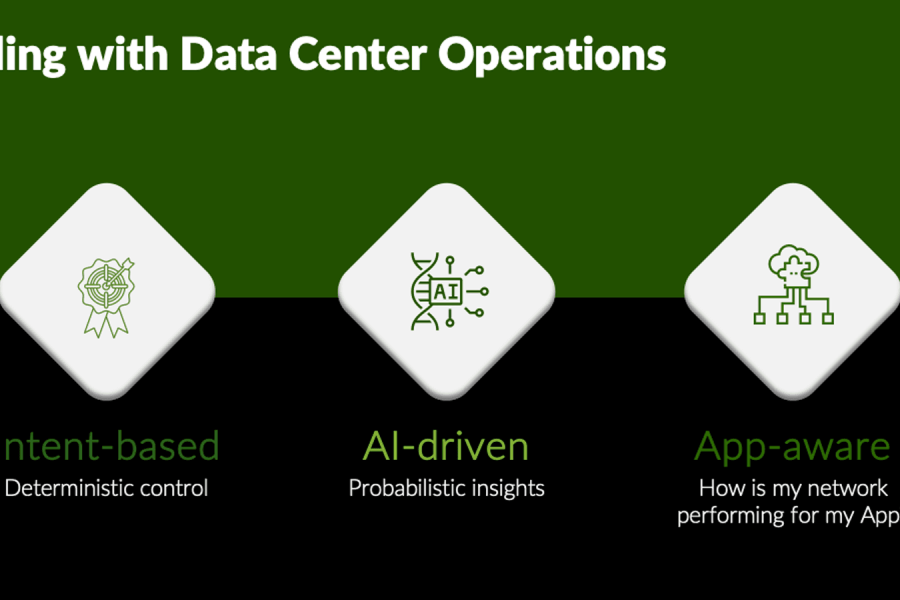This blog was originally published to the Apstra website – in 2021, Juniper Networks acquired Apstra. Learn more about the acquisition here.
 So how to avoid hardware vendor lock-in? Enter Intent-Based Networking. Apstra pioneered Intent-Based Networking to free IT from vendor lock-in. How? It does this by using this three-pronged approach:
So how to avoid hardware vendor lock-in? Enter Intent-Based Networking. Apstra pioneered Intent-Based Networking to free IT from vendor lock-in. How? It does this by using this three-pronged approach:
1. Abstracting Away Hardware (and Offering Hardware Vendor Choice) Through Intent
Intent-Based Networking starts at the system level. These requirements are defined by the end-user and incorporate all the capabilities that the customer needs from their infrastructure. These capabilities include underlay connectivity, overlay, security, compliance, policy, performance, traffic engineering, application performance, SLAs, etc. Requirement and services definition is done at the system level without any dependency or selection of a specific hardware platform or device operating system. Once the user’s intent is specified, the user has the flexibility to choose specific hardware devices and operating systems. It is only at this point that these requirements are translated into specific vendor decisions, configurations, and telemetry gathering. This translation is done by Intent-Based Data Center Automation powered by Intent-Based-Networking technology. The Apstra Operating System (AOS®) is such a solution — AOS knows how to control the device through configuration commands and how to extract telemetry from the device.
If a hardware vendor neglects to or inadvertently fails to maintain consistency with any of their prior APIs, Intent-Based Data Center Automation simply modifies the interface to that API to take advantage of the latest APIs. In doing so it takes on the role of the expert on the differences between vendors (even between the same vendor’s own products) ensuring that customers make best use of each vendor’s equipment and features while avoiding any pitfalls.
This enables Intent-Based Data Center Automation to provide the widest range of hardware and software vendor choices that has ever existed in the industry. For instance, Apstra AOS supports established vendors (Cisco, Arista, Juniper), as well as open alternatives (Cumulus, OpenSwitch, SONiC).
This unique approach allows Apstra to support, develop, update, configure, and test hardware platforms and device operating systems faster than end users would need to deploy new versions of these platforms. This applies to the latest version of a device OS and new vendor platforms that an end-user is deploying in their infrastructure.
Whether a business is building a new data center, refreshing an existing data center, or upgrading a few devices in the data center, the IT team is able to accelerate qualification of the hardware platforms and operating systems by leveraging the testing, qualifications, and support that Apstra has already done. IT benefits from Apstra’s testing of devices and Switch OS’s in their infrastructure and with their configuration before they consider going ahead and deploying it. Apstra AOS also translates user requirements and services across multi-vendor implementations which ensures interoperability between different vendors.
2. One throat to choke without Lock-in
When a customer automates their infrastructure using Intent-Based Data Center Automation, the vendor providing the solution stands behind the entire system and services delivered by the infrastructure, including the hardware devices that make up this infrastructure. In Apstra’s case, we act as the “one throat to choke” without forcing hardware vendor lock-in. Customers get the benefit of choice without the risk of going it alone. This commitment includes the following:
- If issues are observed in the infrastructure, the customer calls Apstra. No questions asked. Apstra is on the side of the customer.
- If Apstra determines that the issue is caused by the hardware vendor or device operating system, Apstra determines if there is a way to mitigate the issue using Apstra Intent-Based Data Center Automation. There are many situations such as memory leaks in processes on the devices which can be mitigated using technologies like Apstra Intent-Based Analytics coupled with Apstra self-healing capabilities.
- If Apstra determines that the issues are beyond the scope of what Apstra can mitigate, then Apstra commits to helping the customer swap the hardware platform or operating system for one that Apstra knows works.
- If the customer is not interested or able to swap out the hardware platform, then Apstra recommends involving the hardware vendor and will join in on initial and ongoing calls at the request of the customer. Apstra will leverage its infrastructure and partners to help debug the issue and get it to the fastest resolution.
Five million tests a day
How is Apstra able to provide this level of support? One reason is that we operate the most powerful automated testbed in the industry. Apstra runs tens of thousands of continuous tests per commit, per branch, across hundreds of devices from multiple vendors including a range of switch operating systems, chipsets, and models, and thousands of virtual appliances from multiple vendors. This amounts to more than five million tests a day.
Apstra is also able to automatically run these tests at our customers’ sites for new hardware platforms which may not be part of the Apstra testbed. If those tests pass, Apstra commits to supporting those devices, also. If those tests fail, then our customers are empowered with this information so they can decide which hardware platforms and operating systems to deploy in their infrastructure.
3. Uniquely Open and Extensible Architecture
Intent-Based Data Center Automation is, by definition, part of a horizontally layered architecture, whereby layers are loosely coupled through APIs to avoid lock-in. The solution operates at the management plane. It supports data planes from various hardware vendors and does not replace the data plane. It supports various control plane protocols from various hardware vendors and device OS vendors and does not replace the control plane.
The network can operate without Intent-Based Data Center Automation. Customers can even turn off the solution completely and the devices, operating systems, and network will continue operating. Customers can then continue controlling them using any other method they wish. Whether manual, or using other automation solutions, or software developed using a DIY model. With genuine Intent-Based Networking, there is absolutely zero lock-in.
In Apstra’s case, we stand committed to never break the Apstra APIs or threaten to do so in order to prevent customers from using other solutions. Apstra’s AOS is driven by open APIs; these open APIs drive the Apstra web UI; they are used to integrate with other systems such as ServiceNow, Slack, Infoblox, etc. Apstra uses protocol buffers to stream out all telemetry. Apstra uses graph queries to manipulate the graph datastore representation that is at the core of our system. Zero lock-in.
The Apstra solution is fully extensible and customizable to meet customers’ specific needs. Contrary to other solutions, Apstra doesn’t expect customers to change their requirements to meet Apstra’s solution — rather, the Apstra solution can be uniquely customized to the user’s requirements. Zero lock-in.
Software First!
Ultimately, Intent-Based Networking enables organizations to move away from their “hardware first” approach. This hardware-first approach is the 30-year old established process that network infrastructure teams choose their hardware first and then design their infrastructure and operations around this choice.
Intent-Based Data Center Automation, powered by Intent-Based Networking enables organizations to take a “software-first approach”. Namely, start with the business needs and the infrastructure services that are required by the infrastructure. Once these are defined, then infrastructure teams and procurement organizations are free to choose the hardware of their choosing based on the criteria they care about: cost, second-sourcing, feature capability, or reliability. The beauty of leverage and choice!
Indeed, digital transformation requires businesses to have the ability to spin up applications in an agile manner, relying on unified infrastructure services and a fungible pool of resources. These requirements can only be met if the infrastructure is cloudified which in turn means depends on the following prerequisites:
- A unified set of APIs and Group-Based Policies
- Infrastructure automation
- Abstract infrastructure components from the system-level services
With a software first model, business priorities can be met by defined and delivering on these capabilities first.
Onward!
This is an exciting time in the industry. Businesses need to digitally transform. In order to do that, they need to change their ways. It is clear that the right solution involves a hybrid, distributed data center — anchored in the private cloud with the option to deploy a multi-vendor solution and an ability to leverage multiple public clouds as needed. With cloud services penetrating the private cloud (e.g. Microsoft with Azure Stack, and AWS with Outpost) customers can no longer afford to take a “hardware first” approach, and lock themselves into one hardware vendor.
Customers can certainly no longer afford to be blindly dependent on their hardware vendors who will use all methods available to them to compel them to abandon a multi-vendor approach and lock themselves into the hardware vendor’s solution.
Apstra pioneered Intent-Based Networking with a mission to break hardware vendor lock-in forever and enable organizations to automate their infrastructures while embracing heterogeneity. Automation and support for multi-vendor and multi-cloud are key to slashing costs and delivering on infrastructure reliability and agility that are required for businesses to deliver on their goals.
Intent-Based Networking breaks the vicious cycle of vendor lock-in by committing to loosely coupled architecture and powerfully open APIs; supporting the widest array of hardware vendor choices; providing a single throat to choke, thus providing choice without risk; And zero lock-in.
If you are committed to deliver on your goals and get off your addiction to your current hardware vendor, please call us — we are delighted to help!


